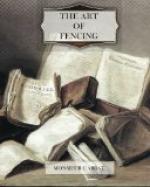Too good an Opinion spoils many People, and too bad a one still more.
A natural Disposition and Practice are necessary in
Lessons, but in
Assaults there must be a Genius besides.
The Goodness of Lessons and of Assaults does not consist
so much in the
Length as in the Manner of them.
When you have to do with one that’s bold and forward, it is necessary to seem apprehensive in order to get a favourable Opportunity.
If you act against one that’s fearful, attack
him briskly to put him in
Disorder.
Before you applaud a Thrust given, examine if Chance had no Hand in it.
Thrusts of Experience, and those of Chance are different, the first come often, the others seldom or never happen, you may depend on one, but not on the other.
In Battle let Valour and Prudence go together, the Lyon’s Courage with the Fox’s Craft.
To be in Possession of what you know, you must be in Possession of yourself.
Undertake nothing but what your Strength and the Capacity of the Enemy will admit of in the Execution.
The Beauty of an Assault appears in the Execution of the Design.
Make no Thrust without considering the Advantage and the Danger of it.
If the Eye and Wrist precede the Body, the Execution will be good.
Be always cautious, Time lost cannot be regained.
If you can hit without a Feint, make none, two Motions are more dangerous than one.
To know what you risque, you must know what you are worth.
If you would do well, acquire the agreeable and useful.
Twenty good Qualities will not make you perfect, and one bad one will hinder your being so.
Judge of a Thrust, rather by Reason than by it’s Success; the one may fail, but the other cannot.
To parry well is much, but it is nothing when you can do more.
Let your Guard, and your Play be always directly opposite to the Enemy.
Practice is either a Good or an Evil; all consists in the Choice of it.
When you think yourself skilful and dexterous, ’tis then you are not so.
’Tis not enough that your Parts agree, they must also answer the Enemy’s Motions.
The knowing a Good without practising it, turns to an Evil.
Two skilful Men acting together, fight more with their Heads than with their Hands.
If you are superiour to your Enemy, press him close, and if you are inferiour, break Measure to keep him moving.
Endeavour both to discover the Enemy’s Design, and to conceal your own.
When the Eye and the Hand agree in the same instant, you are perfectly right.
Draw not your Sword, but to serve the King, preserve your Honour, or defend your Life.
CHAP. XXXI.
Against several erroneous Opinions.




